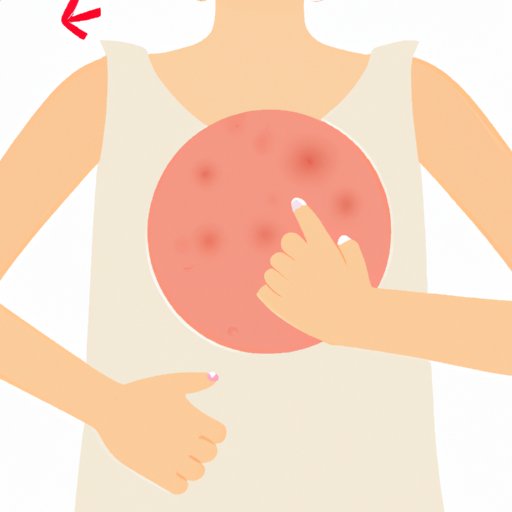Introduction
Hives, also known as urticaria, are raised, itchy red bumps that can suddenly appear on your skin. They can vary in size and shape and usually last for a few hours before disappearing. Hives can be caused by allergies, infections, medications, or even stress. In this article, we will explore what hives look like on skin, the different types of hives, and how to recognize and treat them.

Exploring the Different Types of Hives and their Appearance on Skin
Hives can come in many shapes and sizes, depending on the type. Here are some of the most common types of hives and what they look like on skin:
Urticaria (hives)
The most common type of hives is urticaria, which can appear as red or pink bumps that are round or oval-shaped. These bumps can be itchy and may have a burning sensation. They can also be raised and swollen. Urticaria can range in size from a few millimeters to several centimeters.
Angioedema
Angioedema is similar to urticaria, but the rash appears as deeper, more swollen bumps. These bumps can be larger than those of urticaria and may be filled with fluid. Angioedema can be painful and can last for days or weeks.
Physical urticaria
Physical urticaria is a type of hives that is triggered by physical stimuli such as heat, cold, pressure, or sunlight. The rash appears as red or pink bumps that are raised and can be itchy. They can range in size from a few millimeters to several centimeters.
Cholinergic urticaria
Cholinergic urticaria is a type of hives that is triggered by exercise or emotional stress. The rash appears as small, red or pink bumps that are itchy and may have a burning sensation. These bumps can be scattered across the body or grouped together.
What to Look for When Identifying Hives on Skin
When identifying hives on skin, there are a few things to look for. First, check for common symptoms such as itching, swelling, and a burning sensation. Then look for the shape and size of the bumps. They can range from small, round bumps to large, swollen welts. Finally, take note of the color of the rash. Hives can be red, pink, or even purple in color.
How to Recognize the Symptoms of Hives
Hives often come with other symptoms that can help you identify them. Itching is the most common symptom, but some people may also experience swelling, a burning sensation, or pain. If the rash is accompanied by difficulty breathing or swallowing, seek medical attention immediately.

Tips for Treating Hives on Skin
There are several ways to treat hives on skin. Over-the-counter medications such as antihistamines and topical creams can help reduce itching and swelling. Home remedies such as oatmeal baths and cold compresses may also provide relief. Avoiding triggers such as certain foods, medications, or allergens can also help prevent hives from occurring.

A Guide to Understanding the Causes of Hives on Skin
Hives can be caused by a variety of things, including allergies, stress, and infections. Allergies are the most common cause of hives. Common allergens include pollen, dust, animal dander, and certain foods. Stress can also trigger hives, as can bacterial or viral infections. It’s important to identify and avoid any potential triggers to prevent hives from recurring.
Conclusion
Hives are a common skin condition that can have a variety of causes. Knowing what to look for when identifying hives on skin can help you determine the best course of treatment. Remember to seek medical attention if you experience any severe symptoms such as difficulty breathing or swallowing. For more information about hives, consult your doctor or a dermatologist.


